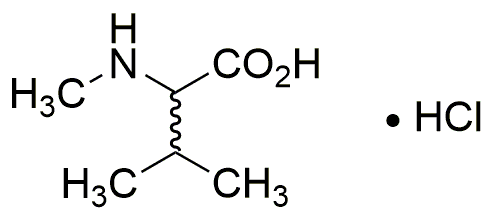N-Methyl-DL-valine is widely utilized in research focused on:
- Amino Acid Synthesis: This compound serves as a building block in the synthesis of peptides and proteins, essential for biochemistry and pharmaceutical research.
- Drug Development: It plays a role in the design of new drugs, particularly in creating compounds that can modulate biological pathways, making it valuable in medicinal chemistry.
- Metabolic Studies: Researchers use it to study metabolic pathways and amino acid metabolism, helping to understand various physiological processes and diseases.
- Biotechnology: In the production of recombinant proteins, N-Methyl-DL-valine can enhance yields and improve the stability of the proteins, benefiting industries like biotechnology and pharmaceuticals.
- Food Industry: It is explored for its potential applications in food science, particularly in developing flavor enhancers or nutritional supplements that can improve health outcomes.
General Information
Properties
Safety and Regulations
Applications
N-Methyl-DL-valine is widely utilized in research focused on:
- Amino Acid Synthesis: This compound serves as a building block in the synthesis of peptides and proteins, essential for biochemistry and pharmaceutical research.
- Drug Development: It plays a role in the design of new drugs, particularly in creating compounds that can modulate biological pathways, making it valuable in medicinal chemistry.
- Metabolic Studies: Researchers use it to study metabolic pathways and amino acid metabolism, helping to understand various physiological processes and diseases.
- Biotechnology: In the production of recombinant proteins, N-Methyl-DL-valine can enhance yields and improve the stability of the proteins, benefiting industries like biotechnology and pharmaceuticals.
- Food Industry: It is explored for its potential applications in food science, particularly in developing flavor enhancers or nutritional supplements that can improve health outcomes.
Documents
Safety Data Sheets (SDS)
The SDS provides comprehensive safety information on handling, storage, and disposal of the product.
Product Specification (PS)
The PS provides a comprehensive breakdown of the product’s properties, including chemical composition, physical state, purity, and storage requirements. It also details acceptable quality ranges and the product's intended applications.
Certificates of Analysis (COA)
Search for Certificates of Analysis (COA) by entering the products Lot Number. Lot and Batch Numbers can be found on a product’s label following the words ‘Lot’ or ‘Batch’.
*Catalog Number
*Lot Number
Certificates Of Origin (COO)
This COO confirms the country where the product was manufactured, and also details the materials and components used in it and whether it is derived from natural, synthetic, or other specific sources. This certificate may be required for customs, trade, and regulatory compliance.
*Catalog Number
*Lot Number
Safety Data Sheets (SDS)
The SDS provides comprehensive safety information on handling, storage, and disposal of the product.
DownloadProduct Specification (PS)
The PS provides a comprehensive breakdown of the product’s properties, including chemical composition, physical state, purity, and storage requirements. It also details acceptable quality ranges and the product's intended applications.
DownloadCertificates of Analysis (COA)
Search for Certificates of Analysis (COA) by entering the products Lot Number. Lot and Batch Numbers can be found on a product’s label following the words ‘Lot’ or ‘Batch’.
*Catalog Number
*Lot Number
Certificates Of Origin (COO)
This COO confirms the country where the product was manufactured, and also details the materials and components used in it and whether it is derived from natural, synthetic, or other specific sources. This certificate may be required for customs, trade, and regulatory compliance.

